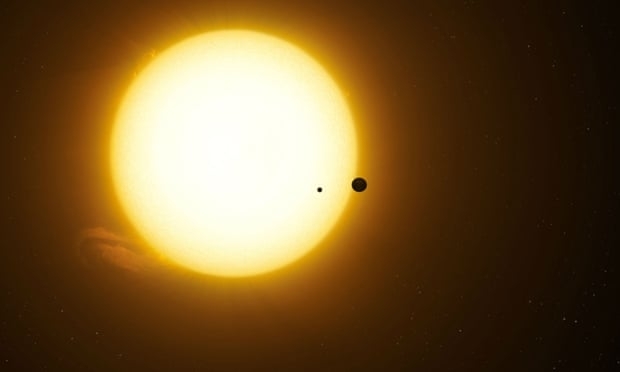The so-called exomoon, which is estimated to be the size of Neptune, would also be the biggest known moon, far exceeding anything known to exist in our own solar system. The team behind the apparent discovery said it needed further confirmation but that they had failed to find any other convincing explanation for their data.
“The first exomoon is obviously an extraordinary claim and it requires extraordinary evidence,” said David Kipping, an astronomer at Columbia University in New York who has spent more than a decade hunting for far-flung moons.
He said the moon’s estimated size was on a scale that had “hardly been anticipated” and “defies easy explanation” based on current theories of moon formation.
Kipping and his colleague Alex Teachey made the discovery after analysing data from nearly 300 distant planets discovered using the Kepler space telescope. The planets are revealed by a momentary dimming of starlight as they pass in front of their host star, in what astronomers call a transit.
Kipping and Teachey noticed strange anomalies in the transit data of a gas planet, Kepler 1625b, which is several times the size of Jupiter.
“We saw little deviations and wobbles in the light curve that caught our attention,” Kipping said.
The findings were intriguing enough to win them 40 hours of observation time on the Hubble space telescope, which is four times more powerful, to investigate further.
Using Hubble, they saw a second, much smaller dip in the star’s brightness 3.5 hours after the planet’s transit, hinting at “a moon trailing the planet like a dog following its owner on a leash”. On another transit, the planet appeared 1.25 hours earlier than predicted. This is consistent with the planet and moon orbiting a common centre of gravity, causing the planet to wobble from its predicted location.
The moon is estimated to be only 1.5% the mass of its companion planet, which is close to the mass-ratio between the Earth and its moon. Our moon is thought to have formed through an early collision with a larger body that blasted off material that later coalesced into a ball. However, Kepler 1625b and its moon are gaseous, not rocky, raising questions about how such a moon could have formed in the first place.
Based on the moon’s distance from its star, its surface temperature was estimated to be 80C, which is considered just on the upper end of conditions that could support life. However, astronomers said they had not dwelled on the question of habitability, since the moon is thought to be composed of gas. It would not resemble the fictional exomoon Pandora in the film Avatar, Teachey said.
More about: #Astronomy
















































